Search results for: 'bronzezeit'
-
 Gruppe von 8 Bronzewerkzeugen
Gruppe von 8 BronzewerkzeugenEtwa 2. Jt. v. Chr. bis 5. Jh. n. Chr., Bronzezeit bis Spätantike. Diverse Gegenstände aus Bronze, darunter Haarpins, zwei Nadeln, ein Spatulum.
Price: on request Bronze Age Elamite ceramic vessel
Bronze Age Elamite ceramic vesselBowl from the Middle Elamite period with painted geometric design. From the area of ancient Iran.
Price: on request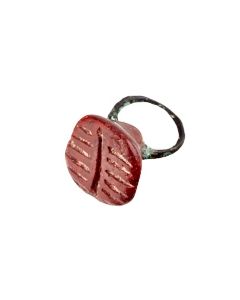 Anatolian porphyry stamp seal
Anatolian porphyry stamp sealBasic shape of a four sided pyramid. Made of wonderful intensely red stone. Middle Bronze Age of Anatolia.
Price: on request Cylinder seal with wrestling scene
Cylinder seal with wrestling sceneStunning white seal made of shell. Mesopotamian Early Dynastic Period III.
Price: on request Early Old Babylonian cylinder seal
Early Old Babylonian cylinder sealCylinder seal made of black rock. It bears a religious scene dating shortly prior to or right at the beginnings of Old Babylonia.
Price: on request Cylinder Seal from the late Uruk period
Cylinder Seal from the late Uruk periodSmall seal made of appealing igneous rock. The engraved wave pattern is typical for the late Uruk period of Mesopotamia.
Price: on request Clay idol from Syria
Clay idol from SyriaFemale figurine from Bronze Age Syria, 3rd to beginning of 2nd millenium BC. With characteristic bird shaped head.
Price: on request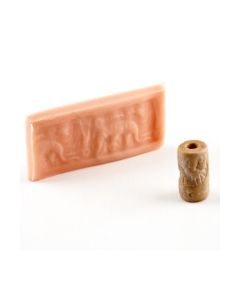 Cylinder seal from early dynastic Mesopotamia
Cylinder seal from early dynastic MesopotamiaDas frühdynastische Rollsiegel aus Mesopotamien zeigt eine Szene mit zwei Personen im Boot, eine davor stehende mit Stab. Es ist aus schönem karamellfarbenem Stein geschnitten. Mitte 3. Jt. v. Chr.
Price: on request Late Bronze age cylinder seal
Late Bronze age cylinder sealLevantinisches Zylindersiegel aus schwarzem Stein. 2. Jt. v. Chr., vermutlich Spätbronzezeit. 16mm lang.
Price: on request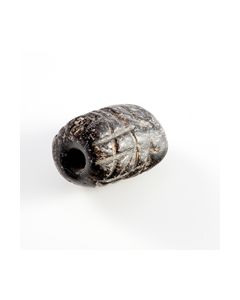 Levantine calinder seal
Levantine calinder sealVorderasiatisches Zylindersiegel aus schwarzem Stein mit geometrischem Motiv. Ca. 17mm lang. Spätbronzezeit.
Price: on request Early bronze age mesopotamian cylinder seal
Early bronze age mesopotamian cylinder sealDas vermutlich sumerische Rollsiegel aus schönem schwarzen Stein trägt ein geometrisches Muster als Motiv. Es stammt aus der Uruk- bis Djemdet Nasr-Zeit, 4. bis frühes 3. Jt. v. Chr.
Price: on request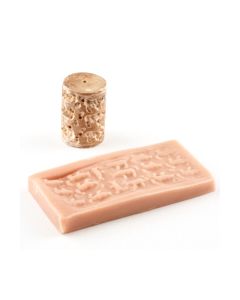 Sumerisches Rollsiegel - Segen der Herden
Sumerisches Rollsiegel - Segen der HerdenSzene mit Herde in Stallung, vermutlich Darstellung göttlichen Segens. Ein Vergleichsfund aus Farah befindet sich im Vorderasiatischen Museum Berlin. 4. bis frühes 3. Jt. v. Chr.
Price: on request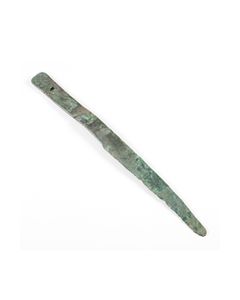 Baktrisches Messer aus Bronze
Baktrisches Messer aus BronzeLanges, schmales Messer. Massiv, sehr gut erhalten, Klinge noch immer scharf. Im Griff Bohrung. ca. 2000 - 500 v. Chr.
Price: on request Tafel mit assyrischem Gesetzestext in Keilschrift aus alter deutscher Sammlung
Tafel mit assyrischem Gesetzestext in Keilschrift aus alter deutscher SammlungFragment einer Tontafel mit altassyrischem Verwaltungs- oder Gesetzestext. Mitte bis Ende des 2. Jt. v. Chr.
Price: on request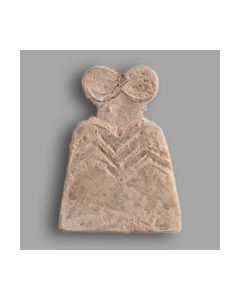 Syrisches Augenidol vom Tell Brak-Typ
Syrisches Augenidol vom Tell Brak-TypHervorragender Zustand mit schön erhaltener Oberfläche. Begutachtet durch Prof. Lambert, mit Notiz aus seiner Hand. Fund aus Tell Brak in den 1920er Jahren.
Price: on request Driking cup of the Troy type
Driking cup of the Troy typeSo-called Depas Amphikypellon from around 2500 BC. The famous type of drinking vessel from Troy as described in Homer's Iliad.
Price: on request Mesopotamian stamp seal in bull shape
Mesopotamian stamp seal in bull shapeThe magnificent seal is from the Jemdet Nasr period. The stamp shows quadrupeds and a scorpion. Published in a book about the Epstein collection.
Price: on request Babylonian clay plaque with erotic scene
Babylonian clay plaque with erotic scenePanel with a religious function in the Old Babylonian Empire. The relief shows a man and a woman during the sexual act, with the woman drinking beer through a straw.
Price: on request Near Eastern bronze sword
Near Eastern bronze swordDouble-edged blade of a Bronze Age sword, the hilt missing. From the middle of the 2nd Millennium BCE.
Price: on request Old Babylonian cylinder seal with gods and inscription
Old Babylonian cylinder seal with gods and inscriptionScene with sun god Shamash and the Amorite god Amurru. The cuneiform writing names the owner of the seal, a faithful servant of these deities.
Price: on request Mesopotamian cylinder seal
Mesopotamian cylinder sealMade of beautiful red stone, worked with the drill. From the transitional period between Chalcolithic and Early Bronze Age in Mesopotamia.
Price: on request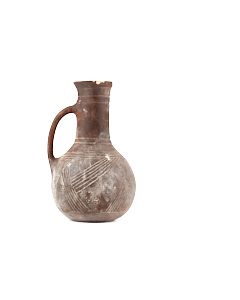 Anatolian clay jug with incised decoration
Anatolian clay jug with incised decorationThe Bronze Age vessel has wonderful linear decorative bands, the white filling of which contrasts with the dark slip. Circa 2500 to 2000 BC.
Price: on request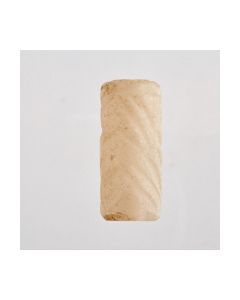 Mesopotamian cylinder seal with abstract scene
Mesopotamian cylinder seal with abstract sceneThe milky white stone is engraved with a scene that stands out by its high degree of abstraction. Late Uruk to Djemdet Nasr period, around 3000 BC.
Price: on request Mesopotamian cylinder seal with fighting scene
Mesopotamian cylinder seal with fighting sceneThe scene shows a fight between hero and lion with animals. Early Dynastic Period III, around 2500 BC.
Price: on request Akkadian cylinder seal of shell core
Akkadian cylinder seal of shell coreTwo lions are fighting with two buffalos. The balance and detail of the scene is an impressive demonstration of the Akkadian seal engraver's skill. Old Akkadian, around 2300 BC.
Price: on request Cuneiform tablet from Umma
Cuneiform tablet from UmmaRecord of beer and bread rations for laborers. Probably from the Bronze Age city of Umma. The cuneiform tablet was studied and conserved at Yale University.
Price: on request Clay tablet with cuneiform script
Clay tablet with cuneiform scriptSmall tablet with well preserved cuneiform engravings. Interesting Bronze Age document from Mesopotamia.
Price: on request Sumerian cuneiform clay tablet
Sumerian cuneiform clay tabletSmall tablet with drill hole. Cuneiform receipt for bricks or pottery. Very well preserved piece from the late 3rd millenium BC.
Price: on request Babylonian carnelian cylinder seal
Babylonian carnelian cylinder sealPrime example made of beautiful orange carnelian. Highly detailed engraved scene with king offering to the weather god Hadad. First half of 2nd Millenium BC.
Price: on request Early Elamite cylinder seal from a museum collection
Early Elamite cylinder seal from a museum collectionCompact seal with geometric design from Elam. 3rd Millenium BC.
Price: on request Western Asiatic button seal with hares
Western Asiatic button seal with haresInteresting button shaped seal from the time of the ancient Assyrian trade settlements in Syria and Anatolia. 19th to 18th cent. BC. From the Dr. Langenkamp collection, with a scientific note from Prof. Mayer-Opificius.
Price: on request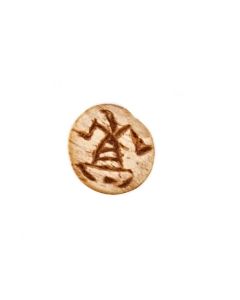 Western Asiatic button seal with scorpion
Western Asiatic button seal with scorpionInteresting button shaped seal from the time of the ancient Assyrian trade settlements in Syria and Anatolia. 19th to 18th cent. BC. From the Dr. Langenkamp collection, with a scientific note from Prof. Mayer-Opificius.
Price: on request Near Eastern cylinder seal
Near Eastern cylinder sealThe seal of black stone bears a scene with four noblemen or gods. Late Syrian, around 1500 BC.
Price: on request Mesopotamian cylinder seal
Mesopotamian cylinder sealThe marble seal bears a fight scene with lions. From the Early Dynastic or Akkadian period in the later 3rd Millennium BC.
Price: on request Clay tablet with cuneiform text
Clay tablet with cuneiform textSmall cuneiform writing tablet with well preserved text on both sides.
Price: on request Cylinder seal with god of the moon and inscription
Cylinder seal with god of the moon and inscriptionCylindrical seal with religious scene and inscription from the Third Dynasty of Ur. A worshipper is lead to the god of the moon Sin.
Price: on request

